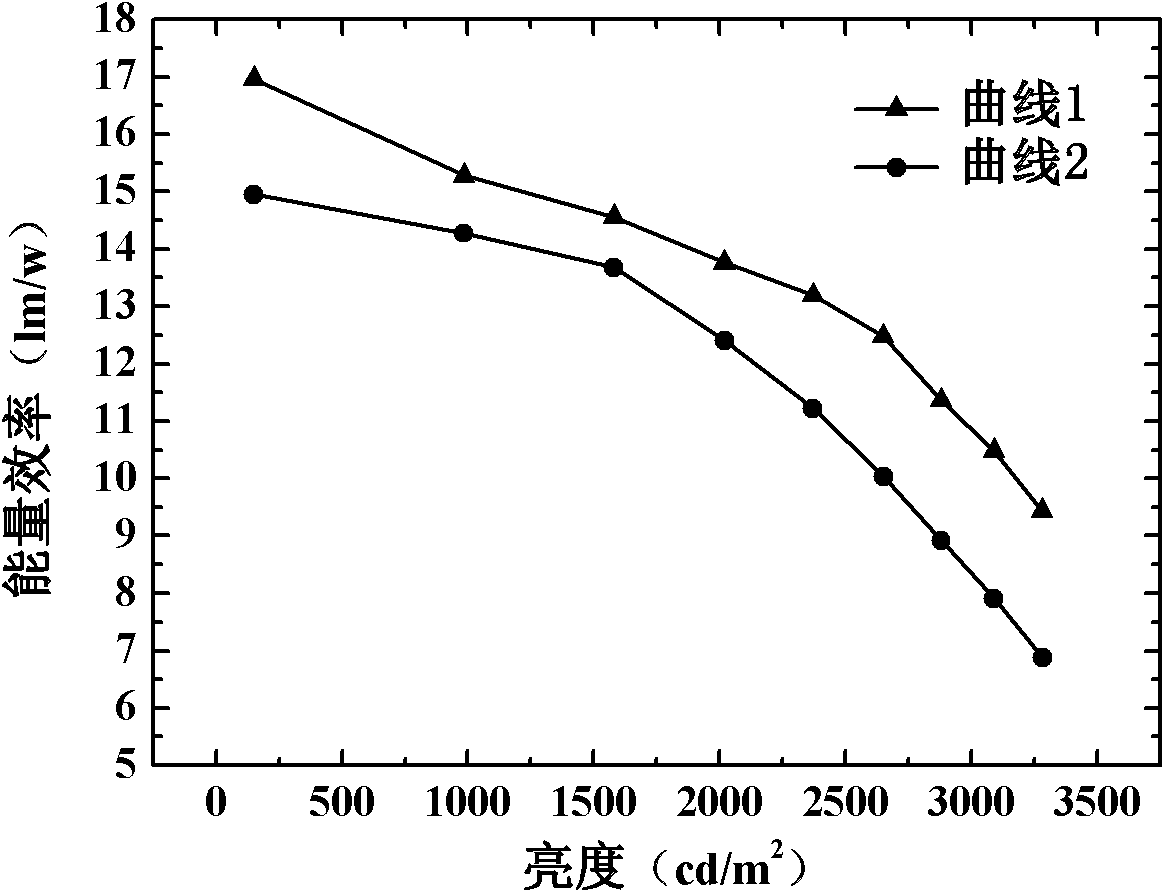White light electroluminescent device
An electroluminescent device and luminescent technology, which is applied in the direction of electric solid-state devices, luminescent materials, electrical components, etc., can solve problems such as poor life and stability of blue light materials, restrictions on blue light emission, and rising device temperature, so as to improve Effect of hole transport ability and electron transport ability, improvement of luminous efficiency, and suppression of concentration quenching
- Summary
- Abstract
- Description
- Claims
- Application Information
AI Technical Summary
Problems solved by technology
Method used
Image
Examples
Embodiment 1
[0048] A white photoluminescent device, its layered structure is: glass / ITO / MoO 3 / NPB / TAPC / TBADN:BCzVBi / BeBq 2 / BeBq 2 :Ir(MDQ) 2 (acac) / TCTA:TPBi / BeBq 2 :Ir(ppy) 3 / BeBq 2 / TBADN:BCzVBi / TPBi / Bphen / Bphen:CsN 3 / Al.
[0049] First, photolithographically process the ITO glass, cut it into the required light-emitting area, and then use detergent, deionized water, acetone, ethanol, and isopropanol to ultrasonically clean the glass surface for 15 minutes to remove organic pollutants on the glass surface. It is subjected to oxygen plasma treatment, the treatment time is 5-15min, and the power is 50W; then each organic functional layer is sequentially vapor-deposited on the ITO conductive layer to obtain a white light electroluminescent device; wherein,
[0050] The material of the hole injection layer is MoO 3 , with a thickness of 5nm;
[0051] The material of the hole transport layer is NPB with a thickness of 10nm;
[0052] The material of the electron blocking layer i...
Embodiment 2
[0068] A white electroluminescent device, its layered structure is: glass / ITO / WO 3 / TPD / TAPC / TPD:TBPe / BeqQ 2 / BeqQ 2 :Ir(MDQ) 2 (acac) / TBADN:PBD / BeqQ 2 :Ir(ppy) 3 / BeqQ 2 / TCTA:perylene / AIq 3 / BND / Cs 2 CO 3 / Ag.
[0069] First, photolithographically process the ITO glass, cut it into the required light-emitting area, and then use detergent, deionized water, acetone, ethanol, and isopropanol to ultrasonically clean the glass surface for 15 minutes to remove organic pollutants on the glass surface. It is subjected to oxygen plasma treatment, the treatment time is 10min, and the power is 50W; then each organic functional layer is sequentially vapor-deposited on the ITO conductive layer to obtain a white light electroluminescence device; wherein,
[0070] The material of the hole injection layer is WO 3 , with a thickness of 10nm;
[0071] The material of the hole transport layer is TPD with a thickness of 5nm;
[0072] The material of the electron blocking layer is TA...
Embodiment 3
[0085] A white electroluminescent device, its layered structure is: glass / ITO / VO x / TCTA / NPB / TCTA:DPAVBi / BeqQ 2 / BeqQ 2 :Ir(piq) 2 (acac) / CBP:Alq 3 / BeqQ 2 :Ir(ppy) 2 (acac)) / BeMQ 2 / TDAPB:DPAVB / BND / TAZ / CsN 3 / Ag-Mg.
[0086] First, photolithographically process the ITO glass, cut it into the required light-emitting area, and then use detergent, deionized water, acetone, ethanol, and isopropanol to ultrasonically clean the glass surface for 15 minutes to remove organic pollutants on the glass surface. It is subjected to oxygen plasma treatment, the treatment time is 15min, and the power is 50W; then each organic functional layer is sequentially vapor-deposited on the ITO conductive layer to obtain a white light electroluminescent device; wherein,
[0087] The material of the hole injection layer is VO x , with a thickness of 40nm;
[0088] The material of the hole transport layer is TCTA with a thickness of 80nm;
[0089] The electron blocking layer is made of NPB w...
PUM
| Property | Measurement | Unit |
|---|---|---|
| Thickness | aaaaa | aaaaa |
| Thickness | aaaaa | aaaaa |
| Thickness | aaaaa | aaaaa |
Abstract
Description
Claims
Application Information
 Login to View More
Login to View More - R&D
- Intellectual Property
- Life Sciences
- Materials
- Tech Scout
- Unparalleled Data Quality
- Higher Quality Content
- 60% Fewer Hallucinations
Browse by: Latest US Patents, China's latest patents, Technical Efficacy Thesaurus, Application Domain, Technology Topic, Popular Technical Reports.
© 2025 PatSnap. All rights reserved.Legal|Privacy policy|Modern Slavery Act Transparency Statement|Sitemap|About US| Contact US: help@patsnap.com



